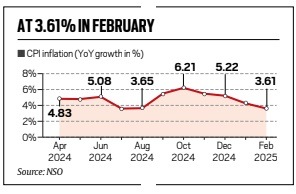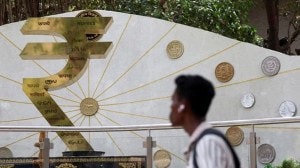Retail inflation eased to a seven-month low of 3.61 per cent in February, compared to 4.26 per cent in the previous month, led by a sharp decline in food inflation, provisional data released by the National Statistics Office (NSO) on Wednesday showed.
Food inflation, based on the Consumer Food Price Index (CFPI), fell to 3.7 per cent, the lowest since May 2023, when it was 3.19 per cent.

Factory output, as measured by the Index of Industrial Production (IIP), also grew by 5 per cent in January, compared to 3.5 per cent in the previous month, led by manufacturing of basic metals, refined petroleum products, and electrical equipment, quick estimates from the NSO showed.
According to retail inflation measured by the Consumer Price Index (CPI), the headline inflation rate in rural India dropped to 3.79 per cent in February compared to 4.59 per cent in January. In urban India, too, headline inflation fell to 3.32 per cent from 3.87 per cent.
On February 7, the Reserve Bank of India (RBI) had reduced the repo rate by 25 basis points (bps) to 6.25 per cent after keeping it unchanged for two years. With further easing of headline inflation in February, comfortably within RBI’s band of 4+/- 2 per cent for medium-term inflation targeting, the central bank could consider another rate cut in the next meeting of its six-member Monetary Policy Committee (MPC) in April.
“The RBI started its rate cut cycle in February and today’s inflation print gives space for the RBI to deliver another 25 bps rate cut in April. Beyond that, a 25 bps rate cut could be delivered in the June or August policy depending on incoming data. We see cumulative rate cuts of 50-75 bps in this cycle for now,” HDFC Bank’s Treasury Research Desk said in a note.
The inflation rate for the food and beverages segment, which accounts for 45.86 per cent of the total weight of CPI, was registered at 3.84 per cent in February, 4.05 per cent for rural and 3.44 per cent for urban.
Story continues below this ad
Food items such as ginger, tomato, and garlic recorded the lowest year-on-year inflation at -35.81, -28.51, and -20.32 per cent respectively. Overall, the inflation rate for vegetables was registered at -1.07 per cent.

“However, we believe that the sequential uptick in vegetables inflation in March 2025 is likely to prevent a further softening in the food and beverages inflation print in the month, after the substantial cooling seen over the past four months. This would push up the CPI inflation print mildly to ~3.9-4.0 per cent in the next month. Overall, the CPI inflation is now expected to average at 3.9% in Q4 FY2025, well below the MPC’s projection of 4.4 per cent for that quarter,” rating agency ICRA’s chief economist Aditi Nayar said.
“The problem areas appear to be fruits and vegetable oils. The latter has also been affected by the volatile rupee which has pushed up imported cost,” Madan Sabnavis, chief economist at Bank of Baroda, said.
The inflation rate for fruits was registered at 14.82 per cent and for oils and fats at 16.36 per cent in February.
Story continues below this ad
On the industrial output front, manufacturing, which accounts for 77.6 per cent of the weight of the IIP, grew by 5.5 per cent in January against 3.4 per cent in December. Mining output recorded a growth of 4.4 per cent against 2.7 per cent in December, whereas electricity output was up 2.4 per cent against 6.2 per cent in the preceding month.
Growth in output of capital goods — an indicator of investment — declined slightly to 7.8 per cent from 10.4 per cent in December. The growth rate was high compared to 3.2 per cent in January 2024.
“At the use-based level, the two lead indicating sectors in IIP – basic goods and intermediate goods – grew more than 5 per cent after a gap of five months. This along with capital goods, infrastructure goods and intermediate goods growing at more than 7 per cent in January 2025 are pointers towards nascent stage of broad-based recovery. However, this should not be treated as full industrial recovery as we have witnessed in the past most of the times, these recoveries fizzle out quickly,” Devendra Kumar Pant, chief economist at India Ratings, said.


































